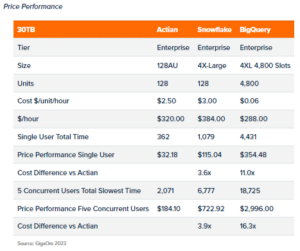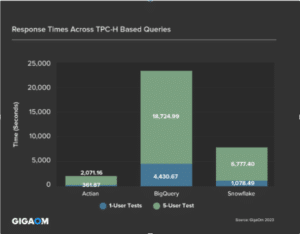Top Capabilities to Look for in Database Management Tools
Derek Comingore
January 2, 2024

As businesses continue to tap into ever-expanding data sources and integrate growing volumes of data, they need a solid data management strategy that keeps pace with their needs. Similarly, they need database management tools that meet their current and emerging data requirements.
The various tools can serve different user groups, including database administrators (DBAs), business users, data analysts, and data scientists. They can serve a range of uses too, such as allowing organizations to integrate, store, and use their data while following governance policies and best practices. The tools can be grouped into categories based on their role, capabilities, or proprietary status.
For example, one category is open-source tools, such as PostgreSQL or pgAdmin. Another category is tools that manage an SQL infrastructure, such as Microsoft’s SQL Server Management Studio, while another is tools that manage extract, transform, and load (ETL) and extract, load, and transform (ELT) processes, such as those natively available from Actian.
Using a broad description, database management tools can ultimately include any tool that touches the data. This covers any tool that moves, ingests, or transforms data, or performs business intelligence or data analytics.
Data Management Tools for Modern Use Cases
Today’s data users require tools that meet a variety of needs. Some of the more common needs that are foundational to optimizing data and necessitate modern capabilities include:
- Data Management: This administrative and governance process allows you to acquire, validate, store, protect, and process data.
- Data Integration: Integration is the strategic practice of bringing together internal and external data from disparate sources into a unified platform.
- Data Migration: This entails moving data from its current or storage location to a new location, such as moving data between apps or from on-premises to the cloud.
- Data Transformation: Transformative processes change data from one format or structure into another for usage and ensure it’s cleansed, validated, and properly formatted.
- Data Modeling: Modeling encompasses creating conceptual, logical, and physical representations of data to ensure coherence, integrity, and efficiency in data management and utilization.
- Data Governance: Effective governance covers the policies, processes, and roles used to ensure data security, integrity, quality, and availability in a controlled, responsible way.
- Data Replication: Replicating data is the process of creating and storing multiple copies of data to ensure availability and protect the database against failures.
- Data Visualization: Visualizing data turns it into patterns and visual stories to show insights quickly and make them easily understandable.
- Data Analytics and Business Intelligence: These are the comprehensive and sophisticated processes that turn data into actionable insights.
It’s important to realize that needs can change over time as business priorities, data usage, and technologies evolve. That means a cutting-edge tool from 2020, for example, that offered new capabilities and reduced time to value may already be outdated by 2024. When using an existing tool, it’s important to implement new versions and upgrades as they become available.
You also want to ensure you continue to see a strong return on investment in your tools. If you’re not, it may make more sense from a productivity and cost perspective to switch to a new tool that better meets your needs.
Ease-of-Use and Integration Are Key
The mark of a good database management tool—and a good data platform—is the ability to ensure data is easy-to-use and readily accessible to everyone in the organization who needs it. Tools that make data processes, including analytics and business intelligence, more ubiquitous offer a much-needed benefit to data-driven organizations that want to encourage data usage for everyone, regardless of their skill level.
All database management tools should enable a broad set of users—allowing them to utilize data without relying on IT help. Another consideration is how well a tool integrates with your existing database, data platform, or data analytics ecosystem.
Many database management tool vendors and independent software vendors (ISVs) may have 20 to 30 developers and engineers on staff. These companies may provide only a single tool. Granted, that tool is probably very good at what it does, with the vendor offering professional services and various features for it. The downside is that the tool is not natively part of a data platform or larger data ecosystem, so integration is a must.
By contrast, tools that are provided by the database or platform vendor ensure seamless integration and streamline the number of vendors that are being used. You also want to use tools from vendors that regularly offer updates and new releases to deliver new or enhanced capabilities.
If you have a single data platform that offers the tools and interfaces you need, you can mitigate the potential friction that oftentimes exists when several different vendor technologies are brought together, but don’t easily integrate or share data. There’s also the danger of a small company going out of business and being unable to provide ongoing support, which is why using tools from large, established vendors can be a plus.
Expanding Data Management Use Cases
The goal of database management tools is to solve data problems and simplify data management, ideally with high performance and at a favorable cost. Some database management tools can perform several tasks by offering multiple capabilities, such as enabling data integration and data quality. Other tools have a single function.
Tools that can serve multiple use cases have an advantage over those that don’t, but that’s not the entire story. A tool that can perform a job faster than others, automate processes, and eliminate steps in a job that previously required manual intervention or IT help offers a clear advantage, even if it only handles a single use case. Stakeholders have to decide if the cost, performance, and usability of a single-purpose tool delivers a value that makes it a better choice than a multi-purpose tool.
Business users and data analysts often prefer the tools they’re familiar with and are sometimes reluctant to change, especially if there’s a long learning curve. Switching tools is a big decision that involves both cost and learning how to optimize the tool.
If you put yourself in the shoes of a chief data officer, you want to make sure the tool delivers strong value, integrates into and expands the current environment, meets the needs of internal users, and offers a compelling reason to make a change. You also should put yourself in the shoes of DBAs—does the tool help them do their job better and faster?
Delivering Data and Analytics Capabilities for Today’s Users
Tool choices can be influenced by no-code, low-code, and pro-code environments. For example, some data leaders may choose no- or low-code tools because they have small teams that don’t have the time or skill set needed to work with pro-code tools. Others may prefer the customization and flexibility options offered by pro-code tools.
A benefit of using the Actian Data Platform is that we offer database management tools to meet the needs of all types of users at all skill levels. We make it easy to integrate tools and access data. The platform offers no-code, low-code, and pro-code integration and transformation options. Plus, the unified platform’s native integration capabilities and data quality services feature a robust set of tools essential for data management and data preparation.
Plus, Actian has a robust partner ecosystem to deliver extended value with additional products, tools, and technologies. This gives customers flexibility in choosing tools and capabilities because Actian is not a single product company. Instead, we offer products and services to meet a growing range of data and analytics use cases for modern organizations.
Additional Resources:
Subscribe to the Actian Blog
Subscribe to Actian’s blog to get data insights delivered right to you.
- Stay in the know – Get the latest in data analytics pushed directly to your inbox.
- Never miss a post – You’ll receive automatic email updates to let you know when new posts are live.
- It’s all up to you – Change your delivery preferences to suit your needs.
Subscribe
(i.e. sales@..., support@...)





















